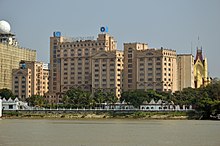Check SBI Payment by KBC
Please wait a moment, We are checking details.
SBI account number is invalid please enter valid account Number.
The State Bank of India (SBI) is an Indian multinational, public Sector banking and financial services statutory body. It is a government corporation statutory body headquartered in Mumbai, Maharashtra. The Corporation is ranked 216th on the Fortune Global 500 list of the world's biggest corporations as of 2017. It is the largest bank in India with a 23% market share in assets, besides a share of one-fourth of the total loan and deposits market.[5][6]
 The bank descends from the Bank of Calcutta, founded in 1806, via the Imperial Bank of India, making it the oldest commercial bank in the Indian subcontinent. The Bank of Madras merged into the other two "presidency banks" in British India, the Bank of Calcutta and the Bank of Bombay, to form the Imperial Bank of India, which in turn became the State Bank of India in 1955.[7] The Government of India took control of the Imperial Bank of India in 1955, with Reserve Bank of India (India's central bank) taking a 60% stake, renaming it the State Bank of India. In 2008, the government took over the stake held by the Reserve Bank of India.
The bank descends from the Bank of Calcutta, founded in 1806, via the Imperial Bank of India, making it the oldest commercial bank in the Indian subcontinent. The Bank of Madras merged into the other two "presidency banks" in British India, the Bank of Calcutta and the Bank of Bombay, to form the Imperial Bank of India, which in turn became the State Bank of India in 1955.[7] The Government of India took control of the Imperial Bank of India in 1955, with Reserve Bank of India (India's central bank) taking a 60% stake, renaming it the State Bank of India. In 2008, the government took over the stake held by the Reserve Bank of India.Operations[edit]
SBI provides a range of banking products through its network of branches in India and overseas, including products aimed at non-resident Indians (NRIs). SBI has 16 regional hubs and 57 zonal offices that are located at important cities throughout India.
Domestic presence[edit]
SBI has 18,354 branches in India.[12] In the financial year 2012–13, its revenue was ₹2.005 trillion (US$28 billion), out of which domestic operations contributed to 95.35% of revenue. Similarly, domestic operations contributed to 88.37% of total profits for the same financial year.[12]
Under the Pradhan Mantri Jan Dhan Yojana of financial inclusion launched by Government in August 2014, SBI held 11,300 camps and opened over 3 million accounts by September, which included 2.1 million accounts in rural areas and 1.57 million accounts in urban areas.[13]







